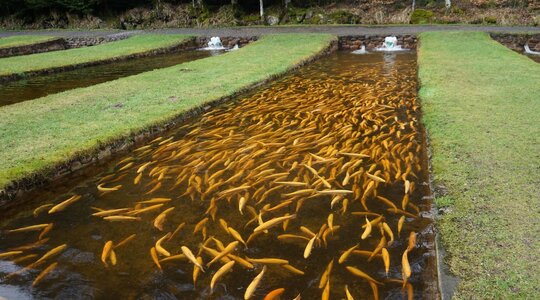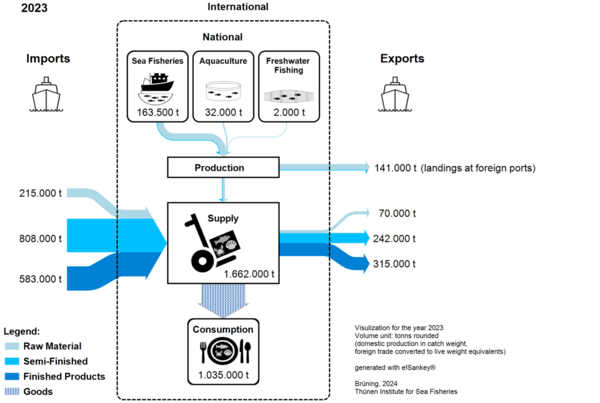Expertise
German aquaculture at a glance
Cornelia Kreiß, Johna Barrelet | 05.01.2026
Over 32,000 tonnes of fish and seafood are produced in average in German aquaculture every year. A seemingly large amount, which only covers a small portion of the domestic demand for seafood.
The production volume of German aquaculture farms for fish and blue mussels (Wadden Sea) amounted to 33,000 tonnes in 2024.
Nearly 51 percent of the total production was farmed in freshwater aquaculture, while around 49 percent was produced in marine aquaculture (primarily blue mussels). Of the freshwater fish, more than half (58 percent) were salmonids: predominantly rainbow trout, followed by salmon trout and sparctic hybrid. Carp accounted for 26 percent of the total fish production.
Wholesale – the most important distribution channel
In 2023, the vast majority of aquaculture commodities (69 percent) were distributed via wholesale. Almost 9 percent of total production was sold directly to customers, with a further 9 percent going to catering, angling parks, and other aquaculture operations. A mere 8 percent were processed directly at the production sites, and only 6 percent went into retail. No corresponding data is available for 2024, but it can be assumed that the distribution channels will be similar to those in 2023.
Inland aquaculture production in Germany mainly takes place in tanks, raceways, and ponds. Only 14 percent of German freshwater aquaculture production is currently being carried out in recirculating systems.
Further information on production systems can be found in the datasheet on animal husbandry in Germany: "Aquaculture."
Small farms - big challenges
Regional aquaculture is characterized by short transportation routes, sustainable production, and good quality products. The sector is dominated by many small operations:
- 52 percent of German aquaculture enterprises produce merely one tonne or less per year. While this size of enterprise is the most common, it accounts for only 2 percent of the sector's total production. Conversely, 21 percent of enterprises produce over 5 tonnes per year. These contribute
- 91 percent of the total production volume.
There has been a steady decline in the sector, with the number of aquaculture enterprises decreasing from over 3,285 in 2015 to 1,978 in 2024 (Destatis 2025). This represents a 40 percent decline. In 2024, 1,875 people were employed in freshwater aquaculture enterprises and 165 in marine aquaculture (BA 2025). The significant decline in aquaculture enterprises can be attributed to a multitude of challenges the sector is facing. Frequently cited issues producers have mentioned include losses to predators (otters, cormorants, herons, starfish, crabs, and seabirds), climate change (particularly water scarcity, heat, heavy rain events, and weather extremes), a lack of successors, rising production and labor costs, as well as bureaucratic obstacles.
Background: Fish consumption in Germany
In 2024, the per capita annual consumption of fish and seafood (based on product weight) in Germany was recorded at 5.4 kilograms (FIZ 2025).
In 2024, salmon was the most popular fish in Germany, followed by Alaska pollock, tuna, herring, and shrimp (FIZ 2025). The majority of these products are purchased in cans and marinades (26 percent) or frozen (26 percent). Fresh fish accounted for only 13 percent of consumed fish. The market share of smoked fish was 9 percent. (FIZ 2025).
The share of fish and seafood from German fisheries and domestic aquaculture in total consumption (self-sufficiency rate) was around 20 percent in 2024 (BMEL 2025). In order to meet the majority of demand, Germany is and has always been dependent on imports of fish products.
The domestic fish and seafood product share is made up of the following: landings of the German fishing fleet (83 percent), catches of commercial inland fisheries (1 percent), and the harvest from German aquaculture (16 percent) (shares for 2024). However, it should be noted that 90 percent of the German fishing fleet's catches are landed in foreign ports and are therefore considered exports.
Download Service
Fact sheets on animal husbandry in Germany: Aquaculture
The fact sheet on animal husbandry in Germany, ‘Aquaculture’, provides an insight into the characteristics of carp farming and salmonid and trout farming. It also contains information on blue mussel production, which is the most important form of marine aquaculture in Germany. In addition, the fact sheet on animal husbandry in Germany ‘Aquaculture’ provides informative data on price trends for aquaculture products and the most important cost factors for aquaculture businesses. It also contains information on employment within the sector.








